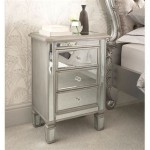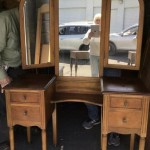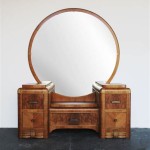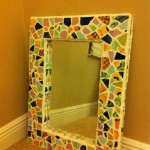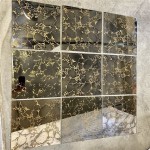DIY Mirror Ideas for Bedroom Enhancement
Mirrors are versatile decorative elements that can significantly enhance the aesthetics and functionality of a bedroom. Beyond their practical use for grooming, mirrors contribute to the perception of spaciousness, amplify natural light, and serve as focal points within the room. Implementing do-it-yourself (DIY) mirror projects allows for personalization, cost savings, and the satisfaction of creating unique décor pieces tailored to individual tastes and bedroom styles. This article explores several DIY mirror ideas suitable for bedrooms, providing insights into materials, techniques, and design considerations for each project.
Framing Standard Mirrors for Personalized Style
A fundamental approach to DIY mirror enhancement involves framing a standard, unframed mirror. This method offers extensive customization options, allowing the mirror to seamlessly integrate with the existing bedroom décor. The choice of frame material, style, and finish directly impacts the overall aesthetic. Common materials include wood, metal, and repurposed items, each offering distinct visual characteristics.
Wooden frames provide a classic and versatile option. They can be crafted from various types of wood, such as pine, oak, or reclaimed lumber, each offering unique grain patterns and textures. Pine is a readily available and cost-effective choice, while oak provides a more robust and refined appearance. Reclaimed lumber adds a rustic and eco-friendly touch. The wood can be stained, painted, or left natural to complement the bedroom's color scheme and style. Staining enhances the wood's natural grain, while painting allows for a wider range of color possibilities.
Metal frames offer a more contemporary and industrial aesthetic. Options include sleek aluminum, brushed steel, or wrought iron. Metal frames can be purchased pre-made or custom-fabricated. The finish, such as polished, matte, or powder-coated, contributes to the overall look. Metal frames are durable and can be easily cleaned, making them a practical choice for high-traffic areas.
Repurposed materials open up opportunities for creative and unique mirror frame designs. Examples include using old picture frames, driftwood, rope, or even mosaic tiles. These materials add character and personality to the mirror, creating a one-of-a-kind statement piece. The use of repurposed materials also promotes sustainability and reduces waste. When using repurposed items, it is essential to ensure they are clean, structurally sound, and appropriately sized for the mirror.
The framing process typically involves measuring the mirror dimensions, cutting the frame material to size, assembling the frame, and securing the mirror within the frame. Accurate measurements are crucial to ensure a snug fit. Wood frames can be joined using wood glue and screws, while metal frames may require welding or specialized fasteners. The mirror can be secured within the frame using mirror clips, adhesive, or caulk. Safety precautions, such as wearing safety glasses and gloves, should be observed throughout the framing process.
Creating a Mirrored Accent Wall for Enhanced Space Perception
A mirrored accent wall is a dramatic and impactful way to transform a bedroom. By covering a wall with mirrors, the room's visual space is significantly expanded, creating an illusion of greater depth and openness. This technique is particularly effective in smaller bedrooms or rooms with limited natural light. A mirrored accent wall can also serve as a striking focal point, adding a touch of glamour and sophistication to the space.
The mirrors used for an accent wall can be individual tiles, large sheets of mirror, or a combination of both. Mirror tiles offer flexibility in design, allowing for intricate patterns and custom layouts. They are typically available in various shapes and sizes, such as squares, rectangles, and hexagons. Large sheets of mirror provide a seamless and more expansive reflection, creating a cleaner and more modern look. The choice between tiles and sheets depends on the desired aesthetic and the complexity of the design.
Proper wall preparation is essential for a successful mirrored accent wall installation. The wall surface should be clean, smooth, and level. Any imperfections, such as bumps or cracks, should be repaired before applying the mirrors. The wall may also need to be primed to ensure proper adhesion of the mirror adhesive. A level is crucial to ensure that the mirrors are installed straight and evenly aligned.
Mirror adhesive, specifically designed for attaching mirrors to walls, is the preferred method for securing the mirrors. It provides a strong and durable bond without damaging the mirror's reflective surface. The adhesive should be applied evenly to the back of the mirror and pressed firmly against the wall. Spacers or shims can be used to maintain consistent spacing between the mirrors, ensuring a uniform and professional appearance. It is important to follow the manufacturer's instructions for the adhesive, including drying time and ventilation requirements.
Safety considerations are paramount when working with mirrors. Mirrors are fragile and can shatter easily if mishandled. Wearing safety glasses and gloves is essential to protect against cuts and eye injuries. When cutting mirror tiles, specialized tools, such as a glass cutter and running pliers, are required. Professional assistance may be necessary for installing large mirror sheets to ensure safe and accurate handling.
Designing a Decorative Mirror Cluster for Artistic Flair
A decorative mirror cluster offers a more artistic and eclectic approach to incorporating mirrors into the bedroom décor. This involves arranging a collection of mirrors of varying shapes, sizes, and styles on a wall to create a visually appealing composition. The mirrors can be framed or unframed, matching or mismatched, depending on the desired aesthetic. A mirror cluster adds personality, texture, and visual interest to the room.
The selection of mirrors is crucial to the success of a mirror cluster. A variety of shapes and sizes creates visual dynamism. Round, oval, square, and rectangular mirrors can be combined to create an interesting mix. Mirrors with different frame styles, such as ornate vintage frames, minimalist metal frames, or frameless designs, add depth and character to the arrangement. Thrift stores, antique shops, and online marketplaces are excellent sources for finding unique and affordable mirrors.
Before attaching the mirrors to the wall, it is helpful to plan the layout and arrangement. This can be done by sketching the layout on paper, arranging the mirrors on the floor, or using painter's tape to mark the positions on the wall. Experimenting with different arrangements allows for finding the most visually balanced and pleasing composition. Consider the spacing between the mirrors, the overall shape of the cluster, and the relationship between the mirrors and the surrounding furniture and décor.
Different methods can be used to attach the mirrors to the wall, depending on their size and weight. Small and lightweight mirrors can be hung using picture hooks or adhesive strips. Larger and heavier mirrors require more secure mounting hardware, such as D-rings and wire or mirror clips. Ensure that the wall anchors are appropriate for the wall type (e.g., drywall, plaster, or concrete) and the weight of the mirrors. It is essential to follow the manufacturer's instructions for the mounting hardware to ensure a safe and secure installation.
Consider adding other decorative elements to the mirror cluster to enhance its visual appeal. This could include incorporating artwork, photographs, or decorative objects between the mirrors. For example, small framed prints, decorative sconces, or artificial plants can be interspersed among the mirrors to create a more layered and interesting composition. The addition of these elements adds texture, color, and personality to the mirror cluster, making it a unique and eye-catching focal point in the bedroom.
Repurposing Old Windows into Decorative Mirrors
Repurposing old windows into decorative mirrors is a creative and sustainable DIY project that adds a touch of vintage charm to a bedroom. By replacing the glass panes in an old window frame with mirrors, the window is transformed into a unique and eye-catching decorative element. This project not only repurposes a discarded item but also adds character and personality to the room.
Sourcing old windows can be done through salvage yards, architectural salvage companies, or online marketplaces. Look for windows that are in good structural condition, with minimal damage to the frame. The frame can be made of wood, metal, or vinyl, depending on the desired aesthetic. The size and style of the window should be appropriate for the intended use and the overall design of the bedroom.
Preparing the window frame is essential for a successful mirror conversion. This involves cleaning the frame, removing any loose paint or debris, and repairing any damage. The frame can be sanded to create a smooth surface for painting or staining. The choice of paint or stain depends on the desired aesthetic and the existing décor of the bedroom. Consider using a primer before painting to ensure proper adhesion and a more durable finish.
Cutting the mirrors to fit the window panes is a critical step that requires precision and accuracy. Measure the dimensions of each window pane carefully and have the mirrors cut to size at a local glass shop or hardware store. Alternatively, you can cut the mirrors yourself using a glass cutter and running pliers, but this requires skill and experience. Handle the mirrors with care to avoid scratches or breakage.
Securing the mirrors into the window frame can be done using mirror clips, adhesive, or caulk. Mirror clips are small metal or plastic fasteners that hold the mirror in place. Adhesive provides a strong and durable bond between the mirror and the frame. Caulk seals the edges of the mirror, preventing moisture from entering and protecting the mirror's reflective surface. Choose the method that is most appropriate for the size and weight of the mirrors and the material of the frame. Ensure that the mirrors are securely attached to prevent them from falling out.
Once the mirrors are installed, the repurposed window mirror can be hung on the wall or leaned against a wall. If hanging the mirror, use appropriate mounting hardware, such as D-rings and wire or heavy-duty hooks. Ensure that the wall anchors are suitable for the weight of the mirror and the wall type. Leaning the mirror against a wall provides a more casual and relaxed look. Consider adding decorative accents around the mirror, such as plants, candles, or artwork, to enhance its visual appeal.
Constructing a Geometric Mirror Mobile
A geometric mirror mobile introduces a dynamic and modern element to a bedroom. This project involves creating a hanging mobile comprised of geometrically shaped mirrors, suspended from a central point. The mobile creates movement and reflections, adding visual interest and a touch of whimsy to the space.
The mirrors used for a geometric mobile can be purchased pre-cut in geometric shapes, such as triangles, squares, hexagons, or diamonds, or they can be custom-cut from larger sheets of mirror. Acrylic mirrors are a lighter and safer alternative to glass mirrors, making them a suitable choice for a mobile. They are also less prone to shattering. The size and number of mirrors will determine the overall size and complexity of the mobile.
The frame for the mobile can be constructed from wire, metal rods, or wooden dowels. Wire is a flexible and lightweight option that allows for creating intricate designs. Metal rods provide more stability and a more industrial look. Wooden dowels offer a natural and rustic aesthetic. The frame should be strong enough to support the weight of the mirrors and should be balanced to ensure that the mobile hangs evenly.
Attaching the mirrors to the frame can be done using wire, string, or fishing line. Wire provides a secure and durable connection, while string and fishing line offer a more delicate and subtle look. The mirrors should be attached in a balanced and symmetrical pattern to ensure that the mobile hangs evenly and rotates smoothly. Experiment with different arrangements and spacing to create a visually appealing design.
Consider adding other decorative elements to the mobile to enhance its visual appeal. This could include incorporating beads, crystals, or small decorative objects between the mirrors. These elements add texture, color, and sparkle to the mobile, making it a more eye-catching and unique piece of art. The addition of these elements should be balanced and harmonious with the overall design of the mobile.
Hanging the mobile requires a secure and stable mounting point. The mobile can be hung from the ceiling using a hook or a pendant light fixture. Ensure that the hook or fixture is strong enough to support the weight of the mobile. The mobile should be hung in a location where it can move freely and catch the light, creating captivating reflections and shadows. Avoid hanging the mobile in a location where it could be easily bumped or damaged.

Bedazzled Mirror Diy Room Decor

Easy Driftwood Mirror The Wood Grain Cottage

20 Gorgeous Diy Mirror Ideas For Your Home Frame Decor
:max_bytes(150000):strip_icc()/bloomingdiyer-372b1cae2a6c43af917f3bea506c11da.jpg?strip=all)
20 Diy Mirror Frame Ideas To Inspire Your Next Project

Mirror Decoration For Home 15 Ideas To Decorate With Mirrors

Diy Wood Floor Mirror Grace Oaks Designs

Mirror On The Wall Makeover Kid Room Decor Bedroom Diy

How To Make A Giant Standing Mirror For Less Than 100 One Crafdiy Girl

41 Diy Mirrors To Add Your Room

Fantastic Decorative Mirror Cute Bedroom Decor Indie Room

